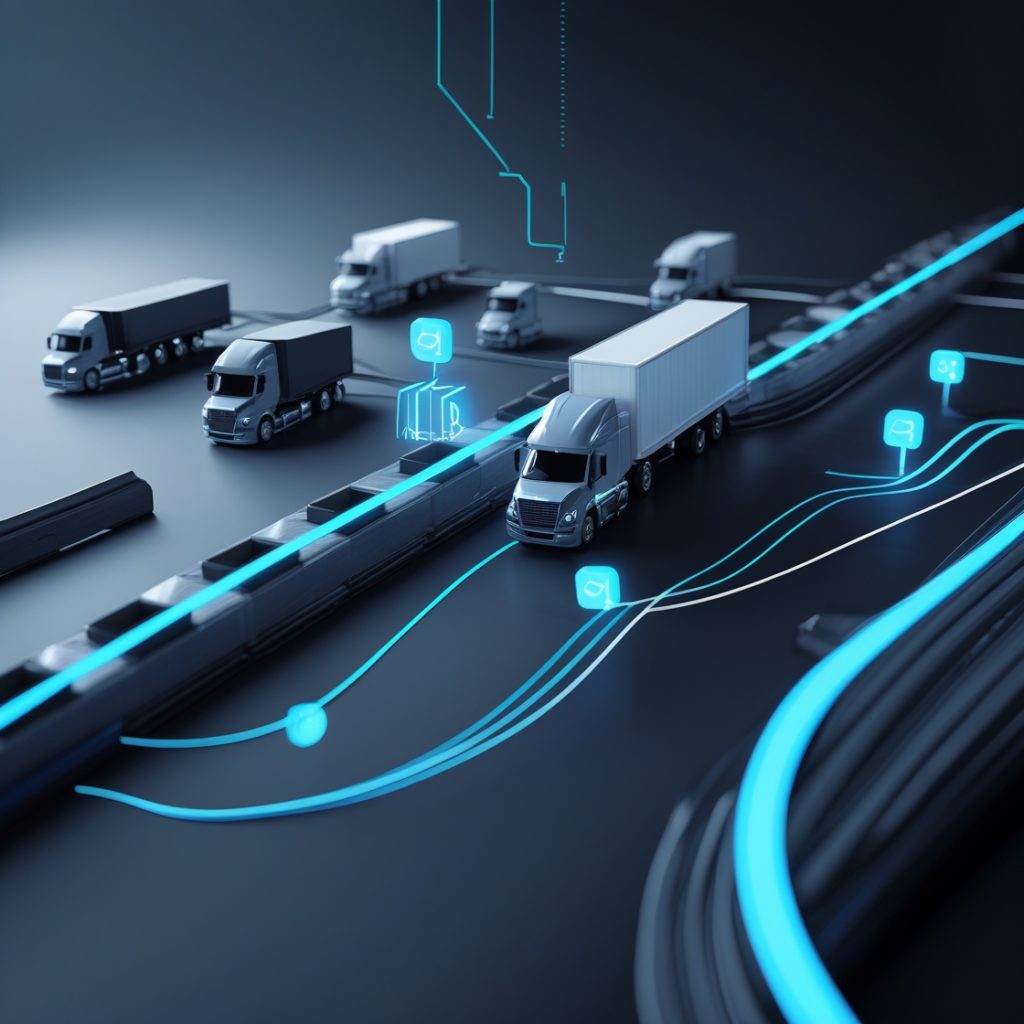In the dynamic world of logistics today, business organizations are finding themselves under more pressure to streamline their operations and stay cost effective. Digital freight transformation has been a consistent strategy to address these pressures, enabling corporate logistics managers to utilize scalable freight solutions and multimodal shipping TMS (Transportation Management Systems) to maximize enterprise freight management.
This article discusses how freight digital transformation reconstructs business efficiency in terms of streamlined processes, enhanced freight carrier integration, and expediting freight carrier interaction and onboarding.
What is Freight Digital Transformation
Freight digitalization is putting digital platforms and technologies into practice that change the manner in which freight planning, execution, and tracking happen. It’s not merely automation; it’s how data, analytics, and cloud technology are being integrated with each other to enable better decision making and end-to-end communication across the supply chain.
The core components are:
- Digital Freight Management Systems: Freight operations aggregated in systems.
- Multimodal Shipping TMS: Solutions that handle more than one mode of transportation (road, rail, air, sea) in a single interface.
- Freight Carrier Integration and Collaboration Tools: Solutions that integrate carriers and shippers for collaborative procedures and real time visibility.
It requires corporate logistics managers to make a shift from legacy driven operations towards scalable freight solutions that facilitate enterprise growth.
Why Freight Digital Transformation Matters for Enterprise Freight Management
Large companies have to tackle complex freight challenges such as managing multiple carriers, multimodal coordination, and adjusting to fluctuating demand. Freight digital transformation addresses these challenges in the following way:
- Improve Visibility: Real-time tracking and analysis enable end-to-end shipment visibility.
- Streamline Collaboration: Freight carrier cooperation and onboarding become simpler through digital platforms.
- コスト削減: Data analytics and automation drive cost-saving capabilities.
- Enhanced Scalability: Dynamic freight solutions elastic to business growth and fluctuating seasonal demands.
- Multimodal Shipping Optimization: TMS solutions integrated enable seamless handling of various transport modes, doing away with inefficiencies and delays.
Multimodal Shipping TMS Role for Enterprise Efficiency
Multimodal shipping TMS is the stage for freight digitalization in enterprises. It enables shipments via various transport modes to be managed on one platform, enabling:
- Consolidated Planning: Consolidate routes, schedules, and freight loads.
- コスト削減: Obtain the optimal freight rates and use the lowest cost carriers and modes.
- リスク管理: Find delays or disruptions before they occur using predictive analytics.
- オートメーション: Automate customs, documents, and billing.
With multimodal shipping TMS that is integrated into enterprise freight management, companies enjoy the independence of making logistics plans in real-time.
Freight Carrier Integration and Collaboration Benefits
Smooth carrier integration is critical to maximize efficiency. Digital freight platforms allow:
- Immediate Data Sharing: Real-time information on freight status, capacity, and performance.
- Simple Freight Carrier Onboarding: Automated digital onboarding reduces administrative hassle.
- Improved Communication: Dedicated communication channels enable coordination and issue resolution.
- Carrier Performance Monitoring: Carrier data-driven scorecards guarantee service quality.
Such consolidation facilitates greater cooperation among freight carriers, allowing companies to rely on their logistics partners to perform reliably.
Scalable Freight Solutions: Scaling to Enterprise Demand
Digital freight transformation provides one of its greatest values: scalability. Companies require freight solutions that can scale to their business requirements:
- Modular Platforms: Allow adding or dropping features as necessary.
- Cloud-Based Platforms: Provide remote access, automated updates, and compatibility with other business applications.
- Flexible Carrier Networks: Support quick addition of auxiliary carriers to handle surge volumes.
- データに基づいた洞察: 貨物量の予測と、それに対応したキャパシティのプロアクティブな拡張をサポートします。
フレートのスケーラブルなソリューションにより、企業の物流担当者は、既存のシステムを置き換えることなく、ビジネスオペレーションを最高の状態に維持できます。
GetTransportは貨物デジタルトランスフォーメーションにどのように適合するか
他のテクノロジーが貨物デジタルトランスフォーメーション機能を提供する一方で、エンタープライズのニーズに焦点を当てることで際立っているものもあります。たとえば、GetTransportには以下のような特徴があります。
- 堅牢なマルチモーダル輸送TMS スムーズな統合により。
- 効率的な貨物運送業者のオンボーディング キャリアネットワークを迅速に構築するため。
- 高度な貨物輸送業者間の連携機能 コミュニケーションを向上させるものです。
- 成長志向のソリューション エンタープライズの成長に合わせて拡張できます。
必ずしも強引な売り込みではありませんが、GetTransportのようなプラットフォームでデジタル貨物管理がどのように推進されているかを理解することで、ロジスティクスマネージャーは、変革プロセスを推進するための適切なツールを判断することができます。
ビジネスにおける貨物デジタルトランスフォーメーションを有効にするためのステップ
貨物輸送のデジタルトランスフォーメーションを活用するためには、企業は以下のロードマップを検討する必要があります。
- 既存の貨物輸送業務の評価: 制約領域を特定し、変更を加えるべき場所を決定します。
- 目標を設定: 経費削減、透明性の向上、オンボーディングの削減など、具体的な目標を設定します。
- 適切なTMSを選択: キャリア接続が可能なマルチモーダル輸送対応ソリューションを選択してください。
- 貨物輸送業者との早期連携: オープンなコミュニケーションチャネルを作成して、コラボレーションを促進します。
- 社内スタッフのトレーニング: 内部チームが新しいデジタルツールや手順に触れる機会を確保します。
- 追跡と改善: 分析を活用して、継続的な貨物戦略を最適化します。
このアプローチを通じて、企業のデジタルトランスフォーメーションは企業の目標と結びつき、効率化における定量的な改善をもたらします。
結論
貨物輸送のデジタルトランスフォーメーションは、現代のグローバル物流市場で競争しようとする企業にとって、今や必要不可欠なものとなっています。マルチモーダル輸送TMS、柔軟な貨物輸送ソリューション、摩擦のない貨物輸送業者との連携と調整により、企業の物流担当者は、企業の貨物管理効率の大幅な向上を達成できます。
これらの進歩の導入は、リアルタイムの可視性、コスト削減、および運用上の応答性の向上をもたらし、企業が進化する市場環境で成功を収めるようにします。GetTransportのようなソリューションは、プロセスを簡素化および削減するテクノロジーの力を示しています。
よくあるご質問
貨物輸送のデジタルトランスフォーメーションとは?
貨物輸送のデジタルトランスフォーメーションとは、TMS、キャリアポータル、分析ツールなどのデジタル技術を活用して、貨物輸送の最適化とサプライチェーンの可視化を図ることです。
マルチモーダル輸送TMSは、企業の貨物管理をどのように改善しますか?
これにより、多数の輸送モードの制御が1つのシステムに統合され、道路、鉄道、海上、航空での貨物の計画、コスト計算、追跡が改善されます。
デジタル貨物管理において、キャリアのオンボーディングが重要なのはなぜですか?
オンボーディングを成功させることで、企業は当初の運送業者基盤を超えて急速に規模を拡大し、変動する貨物需要に対応するための柔軟性と能力を備えることができます。
スケーラブルな貨物ソリューションとは?
スケーラブルな貨物ソリューションとは、企業の動的な物流ニーズに合わせて規模を拡大したり、成長したりすることができ、出荷量の増加や機能の強化に対応できる適応的なソリューションを指します。

 貨物デジタルトランスフォーメーションがいかに企業の効率性を高めるか">
貨物デジタルトランスフォーメーションがいかに企業の効率性を高めるか">